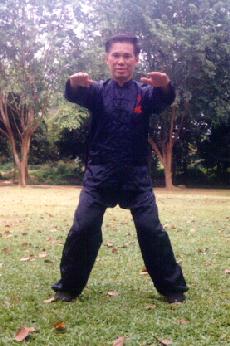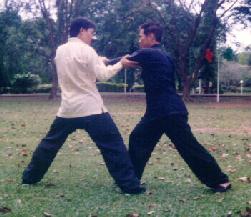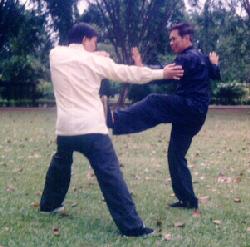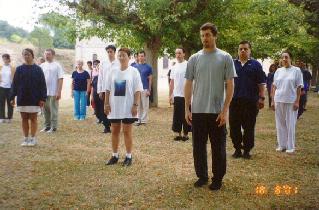April 2001 (Part 3)
SELECTION OF QUESTIONS AND ANSWERS

“Lifting Water” is a very effective method to develop “jin” or internal strength, but it has to be taught by a master. Learning from books, videos or incompetent instructors usually result in performing it as a gentle exercise.
Question 1
What is explosive power or jin?
— Jutaro, Malaysia
Answer
Jin is the usual term in kungfu to refer to internal force, in contrast to li which refers to muscular strength. A principle tenet of kungfu, especially internal kungfu, is to use jin and not li.
Those who are unfamiliar with these Chinese terms are puzzled by expressions commonly found in internal art training like “Don't use strength and you will get a lot of strength”. What is meant is “Don't use muscular strength (in internal training) and you will get a lot of internal force.”
Those who have no experience of jin will not know what the above expression means, although they know the dictionary meaning of every word in the expression. It is similar to those who have not tasted a tangerine will not know the difference in taste between an orange and a tangerine.
Jin is frequently used to strike an opponent at very close quarters, in which case it is described as “explosive power” because the force manifested is tremendous. But there are also aspects or applications of jin that are not explosive, such as when a kungfu master remains solid like a mountain. Moreover, even when a master manifests “explosive power”, he remains calm and composed, unlike the grimacing and screaming in some external martial arts.
Question 2
How can we develop jin? How do we know we have sufficient or abundant jin to apply it?
Answer
There are many methods to develop jin, and none of these methods employ muscular strength. Once you use muscular strength, which involves tensing your muscles, you interrupt the flow of jin. The principal “ingredient” of jin is qi, or vital energy.
For convenient, jin may be “hard” or “soft”. Hard jin results when your qi “soaks” up your tissues, making your arms or body tremendously powerful.
A very effective method to train hard jin is “Golden Bridge”, which is a fundamental art in Southern Shaolin Kungfu. If you train “Golden Bridge” daily for many years, not only a strike with your arm can easily break your opponent's bones, his weapon attack on your body may not harm you.
Soft jin results when your qi flows smoothly and fully. An effective method to train soft jin is “Lifting Water”, which is so important in Taijiquan that it is found at the beginning of Taijiquan sets of all styles. “Lifting Water” is also found in Shaolin Kungfu, as in the art of Golden Bell. If you train “Lifting Water” every day for many years, you can develop such tremendous internal force that you can send an opponent flying back over twenty feet by a seemingly gentle push.
It is very important to accept the fact that powerful internal force training like the examples given above, has to be learnt from and supervised by a master. “Golden Bridge” and “Lifting Water” look simple, and are actually simple in the hands of a master, but it is very easy for self-taught students to make mistakes that can lead to very serious injury.
On the other hand, countless Taiji dancers have performed “Lifting Water” countless times. Why haven't any of them developed internal force. The answer is simple. They have performed it as physical exercise, and not as chi kung, which is energy exercise. You have to learn energy exercise from energy masters; and not from books, videotapes or dancing instructors.
How does one know he has sufficient jin to apply it, is an academic question. Only those who have no jin would ask such a question, and no matter what the answer is, they would not benefit from it, except perhaps for some intellectual pleasure.
Those who have some jin, even not much, would know whether theirs is sufficient for any application. How? Simple by applying it. They would also not ask "What is jin ?".
How abundant your jin is, is relative. The jin you have to push a small boy flying twenty feet backward, is insufficient to move a master an inch.
Question 3
I wish to develop my kung fu from scratch. I have much information on kung fu training but it's all jumble up so I now decide to start from stance training, which is the basis, right?
Answer
Here are five golden steps to get maximum results in minimum time in kungfu training:
- Have a good understanding of what kungfu is.
- Define your aims and objectives in practising kungfu.
- Search for a master or at least a competent instructor who can best help you to realize your aims and objectives.
- Practise, practise and practise according to what your master or instructor asks you to.
- Evaluate your progress with reference to your set aims and objectives.
Your approach to kungfu training is what many people would do. Even if you and they have spent much time and effort on the training, you would in the end be disappointed. If you examine what you would do with the five golden steps, you would not be so surprised.
Despite your good intention and determination, you have not followed any one of the five steps. You may have a lot of information on kungfu training but you still do not have a good understanding of the meaning and scope of kungfu.
For example, you do not understand that while stance training is a basic requirement in good kungfu development, by itself it is not kungfu. In principle you make the same mistake that most modern kungfu students make: they spend a lot of time on set practice, without realizing that by itself set practise is not kungfu.
More seriously, like most people you fail to appreciate the fact that the important thing in any art is not merely knowing the techniques, which can be read from books or copied from videotapes, but practising the techniques correctly, which for beginners needs to be supervised by a competent instructor. If you persists on your stance training on your own basing your training on your self-acquired information, it is likely you would hurt yourself.


Taijiquan is a martial art, not a dance. Two essential dimensions of any martial art is force training and combat application, which have to be learnt from a master. One combat application of Taijiquan is show above. As Goh Kok Hin pulls Sifu Wong, Sifu Wong steps forward diagonally and counters with “Cross-Hands Thrust Kick”.
Question 4
So how do we train our stance? How long per session? What if I can't bear it at first, because for a beginner to do 2 hours is very unbearable. But what is the true period for a beginner?
Answer
All these are academic questions, which mean they are good only for intellectual discussion, and are not likely to produce practical benefits. Nevertheless, I shall answer the questions.
You train you stance, especially the Horse-Riding Stance, every morning, assuming the position described by masters. Make sure you are relaxed physically, emotionally and mentally. Start with a comfortable period per session, say a minute. Gradually increase your time of training.
When you first feel the stance unbearable, continue to bear it. When you feel it extremely unbearable, complete your training session. Nobody expects a beginner to do 2 hours of stance training. If he can remain at the Horse-riding Stance correctly for 5 minutes, he would have done remarkably well.
There is no “true” period. Some masters may advise 5 minutes, others 10, but I would advise a fresh beginner to start at a minute, which actually is not easy for many people when the Horse-Riding Stance is performed correctly. I am making this statement from years of personal experience.
The above is actually good advice. Then, why do I say these academic questions and their answers not likely to produce practical benefits. There are a few reasons, and the most important is the presumption that the students involved practise the stance regularly, and they practise correctly.
Most people do not even practise the stance regularly. They just read the answers and store them as intellectual information. Some may practise for a few days, and then stop practising.
Some, like you, may practise diligently and regularly. But when you are a beginner practising on your own, it is most likely you will practise wrongly even though you intellectually know the correct procedure and method. For example, you are likely to be tensed physically, emotionally and mentally when you know you should be relaxed.
Then, how would you get practical results? Learn stance training from a competent instructor. Once you do so, you won't ask those academic questions. If you ask, as you may sometimes do, you don't need my answers because your instructor will advise you. Even if you want my answers, without observing you in action, my answers given generally may not be suitable for your particular situations.
Question 5
I attempt it like this: hold a horse riding stance for 1 minute, then rest for 1 minute. I do it 3 times per day which means 3 sets per session. Is this correct? I don't mind the hard work; I just want to become a great martial artist.
Answer
There is no hard and fast rule on how to practise the Horse-Riding Stance. My method is as follows.
“Sit” correctly on the Horse-Riding Stance for as long as you comfortably can. Then gradually increase the time of sitting. Practise just one session per day. Initially you may spend just a minute or two on the stance.
When you can sit correctly and comfortably for 5 minutes, you would have attained the minimum requirement for this basic training. This may take you about three months of daily practice. The emphasis is sitting on the stance correctly.
Hard work is necessary for accomplishment in any art. If you mind any hard work, you may as well forget about genuine kungfu training.
But putting in hard work on stance training alone is not the way to genuine kungfu training, not even at an ordinary level. For your sake, for the time being forget about becoming a great martial artist. You would certainly achieve more if you just concentrate on becoming a good kungfu student.
The first thing an aspiring good student does, is to find a master, or at least a good living instructor. You are not even ready to make this effort, but expect to be proficient by learning from books. You certainly have a much mis-informed idea of what genuine kungfu training is.
Question 6
What is the real version of Yijinjing? I saw in some books that it is performed standing. Then I saw in a newspaper an old person teaching it sitting like meditation.
Answer
I don't know what the real version is, and I doubt anyone else knows. I believe the Yijinjing, or Sinew Metamorphosis, I teach is close to the original version, but all other masters or even mediocre instructors feel the same way. The version I teach is performed standing, and corresponds closely to what classical Shaolin kungfu texts described Yijinjing to be.
But most masters are not concerned with which one is the real version. What they are concerned is that the Yijinjing they teach produces the results the art is traditionally reputed to produce, i.e. good health, vitality, mental freshness, spiritual joy and tremendous internal force which can be used for both combat and non-combat purposes.
Question 7
I am looking for a good and reliable teacher to teach me the art deeply but I can't find one. Some teachers I find are too much money-minded and some just have big mouths. Sorry that I speak in this way, but it is really what I observe. Can you please help me because I really don't want to waste any time since I am now 21 and we are getting older each moment. So can you recommend some masters around my area?
Answer
There are two main reasons why you, and most other people in similar situations, cannot find a good and reliable master. One, true kungfu masters are very rare today. But if you are contented with a good, reliable teacher who may not necessarily be a master but who is more than adequate to help you in your kungfu development, your task will become much more easier.
The second reason is that, despite what you have said, you did not really search for a good, reliable teacher — you merely hope that one will conveniently drop on your laps for your service.
You have to be reasonable. While there may be some who are money-minded and big-mouthed, professional kungfu teachers teach for a living. They have no obligation nor interest to teach you on your terms just because you want to become a great martial artist. They also do not want to waste their time.
The 5 golden steps mentioned earlier are excellent in helping you to save time and achieve good results. But you still have to spend some time and a lot of effort to implement the 5 steps. And remember when you have found a teacher, irrespective of whether he is a good or a poor one, you learn what he teaches. You do not tell him, or even expect him, to teach the ways you want him to — including the fees he charges or the material he passes on to you. If you are dissatisfied with his teaching, you can leave him, but do so respectfully.
Generally it is not my policy to recommend teachers to those whose nature, needs and abilities I have not understood. More significantly, the actual search for a master is an important learning experience, and I do not wish to deny you this developmental stage.

A regional Yi Jin Jing or Sinew Metamorphosis class in Spain
Question 8
Some days ago I saw a webpage teaching a technique to make “Chi Balls” that could be used in combat situations, and also some kind of Chi Field to protect you from several attacks.
Is that real, or is it just some kind of myth that this person used to get people visit his webpage?
— Federico, Argentina
Answer
It is quite easy to make “chi balls” and “chi fields”. You can actually make them in 10 minutes. The methods are simple and safe, and are as follows. You can try them for fun.
Place your two palms close together, about 6 inches apart, in front of your body. Slowly and gently bring them closer together to about 2 or 3 inches apart. Then slowly and gently bring them farther apart, to about 6 inches and then 1 foot. Repeat many times until you can feel some magnetism or electric currents between your two palms. You have successfully created a “chi ball”.
The movements of your palms need not necessarily be horizontal. They can be at any angles, but the palms must be facing each other. You may perform this and the following exercise standing, sitting or in any comfortable position, but you must be focused and relaxed.
Now gently place your “chi ball” above your head, and gently think of the chi flowing down, covering your body. Use your palms to gently stroke down your body, a few inches above your skin, to help the chi make a “chi field” around your body. You can also make a “chi field” around your friend's body.
The “chi ball” and the “chi field” are real, but for most people they are so weak that their effects are marginal. But a master who has practised these exercises for, say, more than twenty years, and coupled with other techniques and skills, can use the “chi ball” to strike others, and the “chi field” to protect himself from attacks.
Thus, what is described in the said webpage is real, not a myth, but it is misleading and the purpose is probably to attract people to the webpage. If your purpose is to strike others, you would achieve 10 times more effect by practising to strike your palms on empty air in front of you, than by making and using “chi balls”.
Question 9
I am wondering if you can recommend a way that I can spend one year or more receiving very intensive traditional training in Taijiquan and Shaolin Kungfu. I am willing to devote all my time to work in exchange for this instruction.
— Mark, USA
Answer
Many people have asked me similar questions. The answers below provide some historical and philosophical background on the very intensive traditional training in Taijiquan and Shaolin Kungfu offered by me.
Spending many years with a master was the traditional way in the past to practise kungfu (which of course included Taijiquan). The student served and worked for the master, who in turn taught the student without charging any fees. The master normally had just one, or the most a few students.
The onus was not learning but practising. Hence, your idea of spending one year to receive very intensive training does not apply. The master would teach the student a technique, and the student would practise it for many months before another technique would be taught. The training was usually very demanding, and to the uninitiated might not appear relevant.
For example, the master might ask the student to sweep the floor and clean the walls with a heavy broom many times a day. If the student complained that the floor and walls were already swept, the master might pick up a few grains of sand on the floor, hit the student saying he was careless. The student would then have to pick grains of sand too.
Or the master might ask the student to catch fish swimming in a stream, and place them in a basin of water, giving clear instruction that the fish must not be hurt. If the student caught no fish, or hurt any fish, the master might hit him, scolding him for being useless or cruel.
When the basin was quite full of fish, the master would pour the fish back to the stream. If the student asked why, the master might say he loved it that way, or he might order the student to shut up and do what was told. Later the student would be grateful to his master when his arms were powerful, his eyesight sharp, and he could grip an opponent with ease.
Later, as times and situations changed, kungfu schools were popular. The master usually had many students, who paid fees and attended regular classes. But the master seldom taught the classes, and his students seldom learned! Then, what did they do? Why did they pay fees? They practised in the classes under the supervision of senior students.
The master only taught senior students, and that was also only once a while! The senior students would practise and practise what little the master had taught them, and then once a while taught other students in the regular classes.
This was the norm in kungfu training at the end of the Chinese dynastic era at the beginning of the 20th century, when kungfu was still a martial art. A kungfu student might not know much about kungfu theory, much less than what a modern kungfu dancer today knows, but he was an efficient fighter.
It was in the 20th century that kungfu deteriorated from a martial art into gymnastics and dance. There was a shift of emphasis from practising to learning, and from force training and combat application to routine sets. When kungfu was a martial art, the emphasis was training force and practising combat application. Now when kungfu is gymnastics or dance, the emphasis is learning routine sets.
As times and situations change, the best mode of training changes accordingly. For our present time and situation I believe my intensive courses are the best mode to provide deserving students an opportunity to learn and practise genuine Taijiquan and genuine Shaolin Kungfu (in contrast to Taiji dance and Shaolin gymnastics). The emphasis in the intensive courses is on force training and combat application. The courses are very intensive, and you must be ready to work very hard.
If you are serious about learning Taijiquan or Shaolin Kungfu as a martial art, and are prepared to put in some time and effort to achieve good results, my best recommendation is to attend my Intensive Taijiquan Course or my Intensive Shaolin Kungfu Course .
You need not learn from me for a year. You need only to learn from me in Malaysia for only a week. But you have to practise on your own for many years what you have learnt in the intensive course. You need not work for me for a year, but you have to pay the training fee of US$1500. If you have no money, then you have to work for someone else and save up the money for the intensive course. If you work hard, certainly you can save more than US$1500 in six months.
You should have some prior experience in Taijiquan or Shaolin Kungfu, or some relevant martial art before taking my Intensive Taijiquan or Shaolin Kungfu Courses. But the most important condition is that you must abide by The Ten Shaolin Laws.
LINKS
Selected Reading
- Shaolin Kungfu Training Programe
- Overcoming Cancer and Experiencing Happiness from Within — Laura Fernandez Garrido
